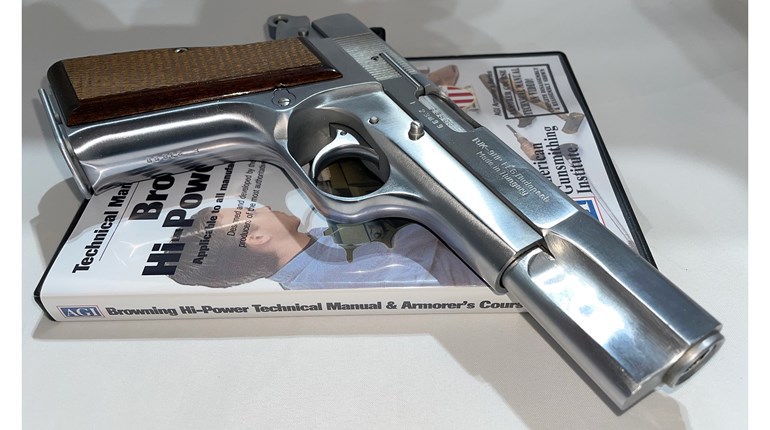
It’s plausible that somewhere in a galaxy far, far away, there exist beings that enjoy cleaning guns. As diverse and demented as our society here on Earth is, there might even be a handful of humans who feel the same way. I’m not one of them. Cleaning guns is not fun, but it’s often necessary.
Before we get into how to clean a gun, let’s look at when it’s necessary. Veterans have participated in their fair share of gun cleaning. When I was in the Army, the rule was—and I’m sure remains—if you shoot it, you clean it. Grandpa was no different; he’d let me look at or shoot his pistol anytime I wanted, as long as I cleaned it when I was done. (I actually enjoyed that, but Grandpa’s pistol was special.) That being said, just because a gun has been fired does not mean it must be cleaned. Part of the reason militaries and Grandpas insist on cleaning all the time is for training. They want you to know how to do it.
I’m no expert on gun cleaning; I don’t do it enough to know that much about it. So, I sought an expert’s advice. I could’ve gone to a manufacturer of gun-cleaning supplies, but that could’ve resulted in a biased opinion. Instead, I turned to Mike Moore, the gunsmith at Gunsite Academy. Keeping the guns used by thousands of Gunsite students operational is his job.

Use the Right Stuff
Moore’s first point was, “There are a lot of ways to do it right and only a few ways to do it really wrong.” His primary suggestion was to use solvents and lubricants made for firearms. “In 33 years of gunsmithing, I’ve seen everything from Marvel Mystery Oil, transmission fluid, vegetable oil and lots of other oils used on guns. Especially with today’s firearms being made of so many different materials, products not intended for firearms can cause damage.”
Firearm maintenance solutions come in three varieties, intended for cleaning, lubricating or protecting (this is where the acronym CLP came from). Solutions used for cleaning are solvents intended to break down carbon, copper and/or lead fouling. Lubricating fluids are designed to make gun parts move more freely with less wear. Protection mixtures help to arrest corrosion.

At the Right Time
The next point Moore brought up is one often disregarded: “When we discuss a fighting firearm, we need to realize it gets carried more than it gets shot. Often, they need cleaning due to the environment they live in, rather than from their triggers being pulled.” This is an excellent observation, because shooters often treat defensive firearms like first-aid kits and fire extinguishers—they’re kept close at hand but rarely serviced.
Firearms that might be used at anytime should receive a regular inspection. For a carry gun, give it a cursory examination everyday. For the behind-the-kitchen-door or truck gun, it should be examined weekly to check for accumulation of debris or corrosion. This might seem like common sense, but it’s not—I once had a police officer show up for qualification, and I found a French fry in his holster.

Moore suggests when taking a training class or after completing an extended range session, your firearm should be field-stripped and cleaned at the end of each day. This keeps your gun in running order, so you can spend class time learning to shoot as opposed to cleaning. It also provides an opportunity to notice excessive wear or potential problems. Upon the completion of a training course, regardless of round count, Moore suggests a detailed cleaning is in order.

Do it the Right Way
Step one is the removal of all fouling and debris. Moore prefers to soak a disassembled firearm in a vat. Most shooters don’t have access to such a resource, but sonic cleaners are an option and do an excellent job. They’re also less labor-intensive than a solvent-soaked toothbrush. An air compressor is very handy too, especially for firearms gobbed with earthy matter. When it comes to the bore, it will require a rod, a brush, patches, bore solvent and some hard work.
Lubricating is where many shooters make mistakes. The old adage, “more is better,” does not apply. Yep, Grandpa used a half-can of 3-in-1 Oil on his rusted fence pliers or his shotgun, and your father probably believed in the liberal application of WD-40 on any moving metal part. With firearms, however, too much is not good. In fact, according to Moore, you should “lightly lubricate.” The technical terminology he frequently uses is, “one drop.” He also warns to not lubricate the firing-pin channel, chamber, bore or magazines, because lubricants often allow debris to stick, and you don’t want stuck debris in these areas.

Protection is the final step. Once your firearm is clean, you need to apply a protective coating to prevent corrosion. How the gun will be used, storage conditions and where this will occur all matter in your choice of protectant and how much to use. You’ll need more protection in locations of high humidity, and especially around saltwater. Regardless, do not get overzealous in the application. Rub it on and wipe it away so only a light coat remains.

Take Good Care of Your Tools
Firearms are tools. They’re the tools of the recreational shooter, competitive shooter, soldier, cop and hunter. Firearms are tools used for protection, and the way you use these tools will impact how often and how comprehensive your cleaning, lubricating and protecting should be. Grandpa might have had different ideas about the proper application of various lubricants, but he did know one truth: If you don’t take good care of your tools, they’ll let you down.




































